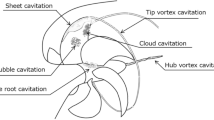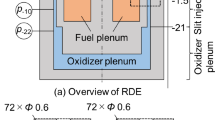Abstract
Wind tunnel experiments and numerical simulations were performed on the cavity over a fuselage of an aircraft to investigate the control effect of passive control devices on pressure fluctuations. The experiments were conducted in subsonic flow, and the control effects of each passive control shape were compared and analyzed. The results indicated that the spoiler- and rod-type devices affect the pressure fluctuation differently, and the reduction effect is excellent when using the cylindrical rod. The changes in the flow structure due to passive control devices were numerically analyzed using unsteady turbulent flow simulation based on the improved detached eddy simulation (IDDES) model. Conditions similar to those in the wind tunnel experiment were applied, and the distribution and trend of the overall sound pressure level were in good agreement with the numerical results. The control effect in the transonic flow was analyzed using a cylindrical rod designed for subsonic flow. The energy cascade of the flow is accelerated due to the passive control device that makes the free shear layer to be unstable. Thus, the feedback mechanism is weakened. And finally, the pressure fluctuation inside the cavity is reduced.
















Similar content being viewed by others
References
Krishnamurthy K (1955) Acoustic radiation from two-dimensional rectangular cutouts in aerodynamic surface, TN-3487. NACA, Washington
Lawson SJ, Barakos GB (2011) Review of numerical simulations for high-speed, turbulent cavity flows. Prog Aerosp Sci 47(43):186–216
Tracy MB, Plentovich EB (1993) Characterization of cavity flow fields using pressure data obtained in the Langley 0.3-meter transonic cryogenic tunnel, TM-4363. NASA, Washington
Plentovich EB, Stallings RL Jr, Tracy MB (1993) Experimental cavity pressure measurements at subsonic and transonic speeds. Static-pressure results, TP-3358. NASA, Washington
Rockwell D, Naudascher E (1978) Self-sustaining oscillations of flow past cavities. J Fluids Eng 100(2):152–165
Zhang X, Edwards JA (1988) Computational analysis of unsteady supersonic cavity flows driven by thick shear layers. The Aeronaut J 92(919):365–374
Stallings RL Jr, Wilcox FJ Jr (1987) Experimental cavity pressure distributions at supersonic speeds, TP-2683. NASA, Washington
Kim TU, Park SH, Lee S, Yu DO, You HC (2019) Analysis of flow oscillation due to sidewall of three-dimensional supersonic open cavity flow. Int J Aeronaut Space Sci 20(4):839–849
Stanek MJ, Visbal MR, Rizzetta DP, Rubin SG, Khosla PK (2006) On a mechanism of stabilizing turbulent free shear layers in cavity flows. Fluids Eng Div Summer Meet 47500:1237–1255
Vukasinovic B, Lucas D, Glezer A (2005) Controlled manipulation of small-and large-scales in a turbulent shear layer, part I: experimental studies. In: 35th AIAA Fluid Dynamics Conference and Exhibit, p 4753
Rusak Z, Eisele I (2005) Controlled manipulation of small-and large-scales in a turbulent shear layer, part ii: stability studies. In: 35th AIAA Fluid Dynamics Conference and Exhibit, p 4754
Arunajatesan S, Shipman J, Sinha N (2002) Hybrid RANS-LES simulation of cavity flow fields with control. In: 40th AIAA Aerospace Sciences Meeting & Exhibit, p 1130
Smith B, Welterlen T, Maines B, Shaw L, Stanek M, Grove J (2002) Weapons bay acoustic suppression from rod spoilers. In: 40th AIAA Aerospace Sciences Meeting & Exhibit, p 662
Ukeiley LS, Ponton MK, Seiner JM, Jansen B (2004) Suppression of pressure loads in cavity flows. AIAA J 42(1):70–79
Lawson SJ, Barakos GN (2010) Computational fluid dynamics analyses of flow over weapons-bay geometries. J Aircr 47(5):1605–1623
Park SH, Kwon JH (2004) Implementation of k-ω turbulence models in an implicit multigrid method. AIAA J 42(7):1348–1357
Spalart PR (1997) Comments on the feasibility of LES for wings, and on a hybrid RANS/LES approach. In: Proceedings of first AFOSR international conference on DNS/LES, Greyden Press
Spalart PR, Deck S, Shur ML, Squires KD, Strelets MK, Travin A (2006) A new version of detached-eddy simulation, resistant to ambiguous grid densities. Theoret Comput Fluid Dyn 20(3):181
Shur ML, Spalart PR, Strelets MK, Travin AK (2008) A hybrid RANS-LES approach with delayed-DES and wall-modelled LES apabilities. Int J Heat Fluid Flow 29(6):1638–1649
Zhang X (1995) Compressible cavity flow oscillation due to shear layer instabilities and pressure feedback. AIAA J 33(8):1404–1411
Welch P (1967) The use of fast Fourier transform for the estimation of power spectra: a method based on time averaging over short, modified periodograms. IEEE Trans Audio Electroacoust 15(2):70–73
Stanek M, Raman G, Kibens V, Ross J, Odedra J, Peto J (2000) Control of cavity resonance through very high frequency forcing. In: 6th Aeroacoustics Conference and Exhibit, p 1905
Rossiter JE (1964) Wind tunnel experiments on the flow over rectangular cavities at subsonic and transonic speeds. In: Aeronautical Research Council Reports and Memoranda
Heller HH, Holmes DG, Covert EE (1971) Flow-induced pressure oscillations in shallow cavities. J Sound Vib 18(4):545–553
Woo CH, Kim JS, Lee KH (2008) Three-dimensional effects of supersonic cavity flow due to the variation of cavity aspect and width ratios. J Mech Sci Technol 22(3):590–598
Acknowledgements
This study was supported by the Agency for Defense Development (No. UD170084JD). This research was supported by the Human Resource Program (Grant No. 20194010201790) of the Korea Institute of Energy Technology Evaluation and Planning (KETEP) grant funded by the Ministry of Trade, Industry & Energy (MOTIE) of the Republic of Korea.
Author information
Authors and Affiliations
Corresponding author
Additional information
Publisher's Note
Springer Nature remains neutral with regard to jurisdictional claims in published maps and institutional affiliations.
Rights and permissions
About this article
Cite this article
Yu, D.O., Kim, T.U., Park, S.H. et al. Passive Reduction of Pressure Fluctuation by Using Cylindrical Rod on Open Cavity. Int. J. Aeronaut. Space Sci. 23, 31–41 (2022). https://doi.org/10.1007/s42405-021-00429-0
Received:
Revised:
Accepted:
Published:
Issue Date:
DOI: https://doi.org/10.1007/s42405-021-00429-0




